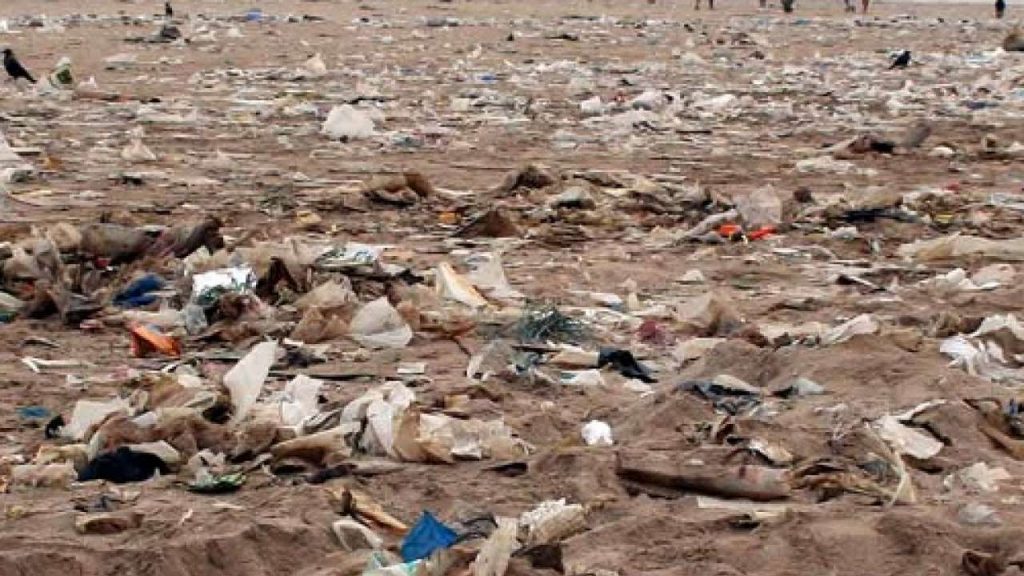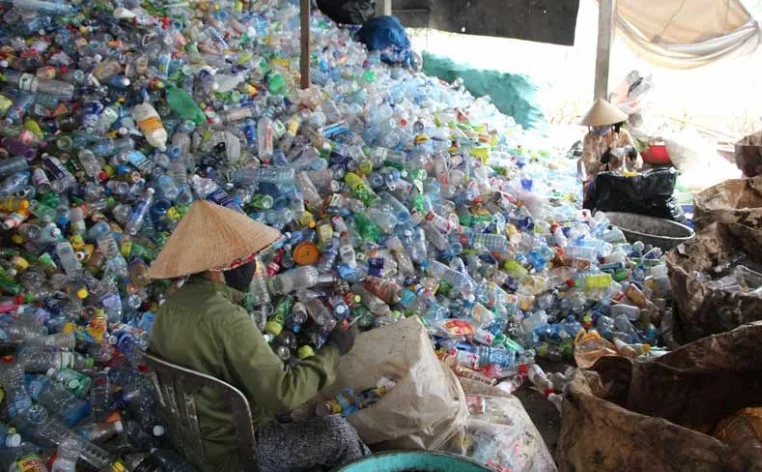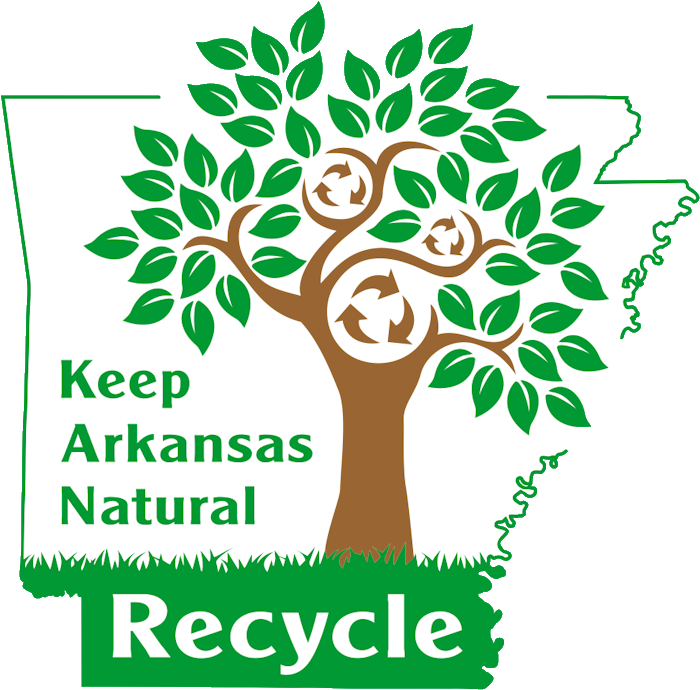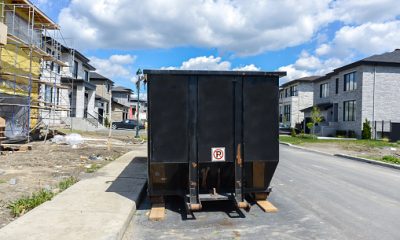Pollution
It Is Important To Know How To Prevent Pollution Of The Land
Published
8 years agoon
By
michelleWhen it comes to land pollution, there are several things you and your neighbours can do to help reduce the pace of the problem. According to groups like with the Environmental Agency, users may take efforts to decrease trash; reverse deforestation; limit chemical use; preserve energy to prevent land contamination and create a greener globe by following these recommendations.
Keeping the Lights On
Cut back on the amount of electricity you use. Nitrogen is released into the atmosphere when fossil fuels are burned to generate electricity. As a result of this nitrogen being returned to the land, soil and water contamination are caused. Devices that aren’t in use should be unplugged from the wall socket and turned off to save energy and money.
Use LED bulbs instead of fluorescent or halogen bulbs in rooms you’re not using and turn off the lights while you’re not there.
Consider purchasing energy-efficient bulbs and appliances, such as washing machines, freezers, and air conditioners.
In the summer, set the thermostat to 77–80 degrees Fahrenheit (25–27 degrees Celsius), and in the winter, 64–68 degrees Fahrenheit (18–20 degrees Celsius).
Make use of clean, renewable energy. Burning fossil fuels is worse for the environment than using renewable energy sources like solar, wind, and hydroelectricity. Find out if you may get your hydroelectricity by contacting your utility company. Solar farms or a wind generator can also be installed to fuel your home or office!

You may be eligible to claim a tax break if you use renewable energy sources in your home.
You can reduce your vehicle’s carbon footprint by doing so. Nitrogen is a pollutant in the air, ocean, and soil that comes from automobile emissions. As a result of drilling for oil contaminating the soil, burning gasoline contributes to land contamination. Instead of commuting by automobile, consider using public transit or carpooling. It’s fine to walk or ride a bike to your final destination.
Flying creates pollutants as well. Try to reduce the flights you fly each year by consolidating or limiting your work travels and vacations.
Decrease Your Expendables
Cut back on the amount of stuff you buy. Everyday things require a large amount and commodities to produce. Don’t buy anything unless you definitely need it to limit the quantity of waste you make! If an item you already own breaks, try to fix it rather than buy a new one. Also, buy secondhand stuff for your home, such as furniture, clothing, games, books, and electronics.
Use something you already have instead than purchasing something new that you’ll only use once or twice.
In addition to reducing waste, using biodegradable materials also saves you money.
Reduce, reuse, and recycle as much as possible. Pollution from landfills is a major cause of environmental damage. If you can, take care of the environment as much of the waste that you produce instead of tossing it away. Aluminum and other metals, glass, plastic, paper, and cardboard can all be recycled.
Sort your recyclables in accordance with your city’s or recycling company’s instructions.
If you don’t have yet a recycling service, inquire about having recyclables picked up at your residence and place of business.
Reduce the amount of plastic you use. The world’s landfills and oceans are overflowing with plastic debris. Reduce your consumption of single-use plastics by not using them in the first place. Another wonderful strategy to reduce plastic waste is to buy bulk items wrapped in boxes rather than plastic containers.
Invest in cloth bags for food storage, such as for leftovers and snacks, and use cloth bags to transport your purchases.
You may like
Landfills
Georgia’s Sorting Revolution: The Latest on Selective Recycling
Published
1 week agoon
April 15, 2024By
michelle
Update on the selective sorting situation in Georgia
Selective sorting, also known as source separation, is a fundamental aspect of recycling in Georgia. For example, it is often necessary for anyone who wishes to undertake certain recycle work to rent a rubble dumpster to clean up their work environment, using local waste management services such as Dumpster Rental Near Me Gainesville.
This process involves separating recyclable materials at the point of origin, typically within households or businesses, into designated categories such as paper, plastic, glass, and metal. It is absolutely necessary to conduct this step, otherwise proper recycling is not possible.
Collection according to environmental challenges
The staff made available to collect household waste do not always check it before sending it to the waste bins. To achieve efficient collection, collection must be organized as follows:
- Door-to-door collection (selective sorting of organic waste, household waste)
- Organization of voluntary collection points
- Local mobile or fixed recycling centers
- Collection of bulky waste on request
- Specific collections: diffuse hazardous waste, textiles
- Alternative transport of electric vehicles, automated collection, river collection points, horse-drawn collection
A collection organized in this way avoids serious errors during destruction. By sorting these materials before they reach recycling facilities, contaminants are minimized, and the quality of recycled materials is improved, facilitating their reuse in the manufacturing processes in Georgia.
Waste recovery services
Selective sorting promotes resource efficiency, reduces landfill waste sent to local landfills in Georgia, and conserves energy compared to mixed waste disposal methods.
These services must have data recovery sheets. They will be used to:
- Identify users of a specific type of material and even the waste that may result from it
- Identify sorting errors
- Carry out a careful analysis of the data in order to consider possible improvements to the service (modification of collection circuits, targeted communication to improve sorting)
Waste recycling
While the implementation of selective sorting varies across counties in Georgia, efforts such as education campaigns and infrastructure development will continue to improve recycling practices statewide, offering a more sustainable approach to waste management in Georgia.
Recycling most often concerns plastic materials because they are non-biodegradable; they are not likely to be degraded by bacteria or other biological agents, and may take hundreds of years tp decomppse.
When plastic materials are thrown into the waste bins brought for sorting, the operation is never won in advance. Sorting agents often start by identifying these different materials by looking for children’s toys, garden items and furniture, etc. They also examine mounds of plastic soaked in non-recyclable garbage such as suspended food or medical waste. The tricky part is when they come across a lot of plastic bottles. Moreover, not all of them can even be reused anymore. One study showed that 24% of plastic bottles were discarded as too contaminated to be recyclable. Clearly, there is still progress to be made in terms of sorting and recycling our waste.
Landfills
Mastering the Art of Recycling: Unveiling Key Insights and Eco-Friendly Tips
Published
8 months agoon
August 15, 2023By
michelle
Recycling: the right things to know
Waste sorting, eco-taxes, collection points… There is no shortage of solutions to promote the recycling of household waste. Faced with the current ecological challenges linked to overconsumption, the development of a circular economy is necessary. What are the right individual actions to adopt to increase the recycling rate in the US and protect the environment? We take stock on the occasion of World Recycling Day.
Recycling: a solution to the accumulation of waste
A few figures allow us to measure the extent of the waste produced each year in the US and Arkansas in particular. In 2015, according to the Environment and Energy Management Agency, the average weight of household waste was 793 kg per year and per inhabitant, including 465 kg stored in bins and containers.
A American person produces twice as much waste as 40 years ago! Recycling has therefore emerged as one of the solutions to stem the problem of household waste.
Respect for the sorting of household waste
Sorting waste has become part of our daily lives, yet Rock Hill and Arkansas are lagging behind. The European Union has set itself a goal of recycling 50% of household waste by 2025. According to recent figures, Arkansas achieved a recycled waste rate of 34.5% in 2021.
For information, paper is recyclable 6 times and aluminum thousands of times. The good gestures to follow are:
- sort waste and place it in the respective bins;
- empty the packaging of its contents to avoid dirt;
- read the sorting instructions on the product packaging;
- use the deposit bins for glass, used clothes, etc.;
- transport bulky items to the recycling centers.
Recycle your food waste into compost
In light of the ecological risks facing our societies, consumers are mobilizing and eco-citizen solutions have been put in place. For the recycling of organic waste, people with a garden can use a composter and city dwellers, a vermicomposter. Advantage: compost, useful for agriculture, includes food scraps, peelings, but also eggshells, dairy products, coffee grounds, breads, paper filters, etc.
Are deposit bins for waste harmful to the environment
Electrical and electronic waste (WEEE) has seen the biggest increase in all household waste worldwide in recent years. In Arkansas, there are collection points managed by local organizations, responsible for recycling.
A good gesture to know is to bring your old device (TV, telephone, printer, household appliance, etc.) back to the store when making a new purchase. Sellers are obliged to take back your used device, which may contain toxic heavy metals such as mercury, lead, calcium, zinc, iron, etc. Most of these components, also present in batteries, can be recycled in industry.
The right things to do to reduce the waste to be recycled
The recycling chain is proving to be complex to manage due to the exponential amount of waste to be processed. To facilitate a circular economy, where products are reusable, it is first necessary to limit the production of waste. Here is a list of the main gestures to know:
- avoid food waste: check the expiry dates, measure the quantities to be cooked;
- buy eco-refills and large format products, avoid superfluous packaging;
- use a reusable shopping bag or basket for shopping. A plastic bag has a lifespan of 450 years and permanently pollutes rivers and oceans;
- refuse advertising in mailboxes;
- drink tap water;
- buy second-hand, sell and give away;
- avoid devices with planned obsolescence and repair yourself;
- use merchants who adopt the return to deposit (infinitely recyclable glass bottles).
How much does it cost to rent a dumpster in Little Rock, AK
Due to the about waste management issues, it could be a good idea to rent a dumpster if you live in Little Rock and if you have a large quantity of junk to discard all at once.
The cost of renting a dumpster in Little Rock, Arkansas can vary based on several factors. Factors such as the size of the dumpster, the duration of the rental, the type of waste being disposed of, and the specific dumpster rental company all play a role in determining the final cost.
On average, for a smaller 10-yard dumpster, you might expect to pay around $250 to $350 for a week-long rental. If you require a larger 20-yard dumpster, the cost could range from $350 to $450 or more for a similar rental period. Keep in mind that these prices are just rough estimates and can fluctuate.
Additionally, the type of waste you’re disposing of can influence the cost. Regular household debris might come with a standard rate, while hazardous materials or construction debris might incur higher fees due to special handling and disposal requirements.
Comparing prices and services from various dumpster rental companies in Little Rock is crucial to getting the best deal. Some companies might offer package deals that include delivery, pickup, and disposal fees, while others might charge these services separately ( check Little Rock Dumpster Rental HQ for fair prices in Little Rock).
The cost of renting a dumpster in Little Rock depends on dumpster size, rental duration, waste type, and the chosen rental company. Researching and obtaining quotes from different providers will help you make an informed decision and manage your waste disposal needs within your budget.
Landfills
Recycling Unveiled: From Waste to Wonder in the Circle of Renewal
Published
9 months agoon
August 5, 2023By
michelle
When the first glass collectors were installed, it was energy savings that motivated the recycling pioneers: melting glass requires less heat than melting raw materials.
Forty years later, sorting has become widespread, with the aim of reducing the volume of residual waste. But we often forget that recycling also allows us not to consume the electricity and water needed to extract and transform virgin raw materials, and that it avoids the emission of large volumes of CO2. Thus, recycling 1 ton of paper and cardboard saves the equivalent of CO2 that a car traveling 250 km would emit. And we throw away more than 1 million tons of cardboard and paper every year…
Cans are reused over and over
We throw away 66,000 tons a year. A third is recycled, of which 6,000 tons come from selective collection.
The circuit: In the sorting center, non-ferrous metal packaging is selected by separators. They are then transferred to the aluminum processing plant.
What do we do afterwards? Other cans, but also chairs, parts for the automobile or aeronautics. With 1 ton of cans collected, we can obtain 586 kg of recycled aluminium. This cycle can be repeated over and over again.
Cardboard and paper are reprocessed up to 10 times
We throw away 1.03 million tons a year. 63% of cardboard and paper packaging is recycled.
The circuit: Once transferred from the sorting center to the recycling plant, the paper and cardboard are immersed in water. Glues, varnishes and staples are eliminated. The paste obtained is drained, pressed and dried to form reels of paper or cardboard.
What do we do afterwards? 92% of packaging is made with recycled paper or cardboard. With 1 ton collected, we obtain 825 kg of recycled paper and cardboard. You can repeat the operation a dozen times, depending on the quality of the papers. With each recycling, the cellulose fibers are damaged.
Nearly three quarters of glass is recovered
We throw away 2.89 million ton/year (all food packaging combined).
The circuit: It has been forty years since the recycling of glass began. Collected in specific containers, used glass is transported by dump truck to dedicated centres. Ceramics, porcelain and crockery are eliminated by optical sorting. The glass is washed, and the bottles and jars are crushed. Cullet is obtained which is sent to the glassmakers.
What do we do afterwards? New bottles: with 1 ton of glass from selective collection, we obtain 962 kg of recycled glass. This material can be reused directly. New packaging is made up of up to 90% cullet. Today, glass bottles and jars contain on average more than 65% cullet. Master advantage of this process: it can be repeated endlessly.
Tin cans are all recycled
We throw away 299,000 ton/year.
The circuit: In the sorting centre, the steel is separated using a magnet. It then heads to the steelworks where it is compacted, crushed and melted. There is therefore no need to wash the boxes before throwing them away: leftover food does not resist melting.
What do we do afterwards? Steel bars that will be used to make cars, pétanque balls, etc., and new boxes. Manufacturers have developed techniques to reduce the thickness of preserves: thus the new cans use less material. For 1 ton of steel from selective collection, we obtain 860 kg of recycled steel. Again, this material can be reused endlessly without loss of quality.
Cell phones are largely incinerated
125 to 150 million devices sleep in our closets.
The circuit: Since 2006, cell phones must no longer be thrown in the trash, but brought to one of the 6,000 collection points spread across the territory. Last year, only 250,000 phones were recovered by the approved sector.
What do we do afterwards? The announced recycling rate is 73.3%. In reality, it is above all a question of energy recovery from appliances which are crushed and then incinerated. Only ferrous metals such as steel (3.2% of the composition of a phone) are reused to make metal frames in construction, and non-ferrous metals, such as aluminum and copper (2.4% ), are recycled to make car parts or cables.
The Plastic Packaging Conundrum
We throw away 3.3 million tons / year (all plastics combined).
The circuit: The plastics collected go to sorting centers (manual, mechanical and optical). In the recycling plant, bottles are sorted by type of plastic — transparent or opaque. They are pre-washed, ground into flakes and melted into preforms. But recycling rates remain low. Only a fifth of plastic packaging is sent to a recycling centre, the rest being incinerated (41.7%) or landfilled/stored (39.1%). California is one of the most efficient states for recycling plastics (20% to 26% on average in the United States).
What do we do with it afterwards? The preforms are sent to the bottling factories to blow new bottles. PET is also used for textiles (fleece, duvet stuffing, etc.). HDPE is used for watering cans, garden benches, garbage cans… Today, in Santa Ana, recycled plastic only accounts for 11% of the composition of industrial products.
List of Sources
- https://eu.usatoday.com/story/news/2023/04/21/how-to-recycle-paper-plastic-glass/11688181002/
- https://www.santa-ana.org/trash-recycling/
- https://theprophetblog.net/how-to-dispose-of-your-old-carpets-with-a-dumpster-rental/
- https://www.santaanadumpsterrental.net/
- https://theprophetblog.net/waste-management-issues-in-the-state-of-nevada/


Georgia’s Sorting Revolution: The Latest on Selective Recycling

Mastering the Art of Recycling: Unveiling Key Insights and Eco-Friendly Tips

Recycling Unveiled: From Waste to Wonder in the Circle of Renewal

Waste Management Issues in the State of Nevada

How to improve waste management in Reno
Trending
-

 Business15 years ago
Business15 years agoWhat Is Bitcoin
-

 Health10 years ago
Health10 years agoHow to Prevent Air Pollution from Harming Your Health
-

 Landfills4 years ago
Landfills4 years agoLandfill Gas: What You Need To Know
-

 Tech14 years ago
Tech14 years agoWhat to do with old computers
-

 Landfills5 years ago
Landfills5 years agoEnvironmental Containment Systems For Municipal Waste Landfills Are Comprised Of A Number Of Components
-

 Waste Management12 years ago
Waste Management12 years agoBiogas waste management
-

 Waste Management6 years ago
Waste Management6 years agoFive Things To Keep In Mind When Trying To Find A Dumpster Rental Company
-

 Recycling12 years ago
Recycling12 years agoPhiladelphia Recycling Blueprint

